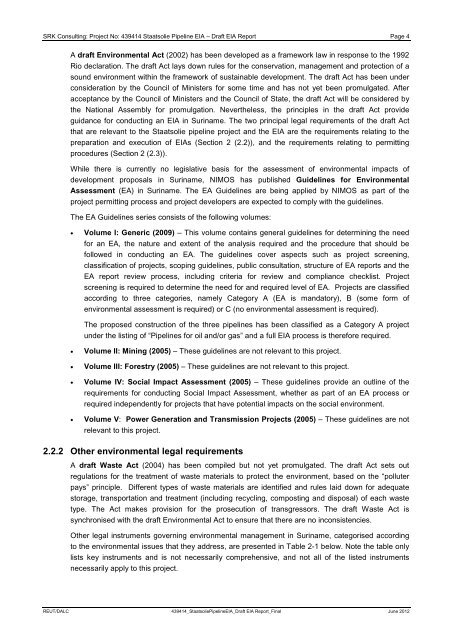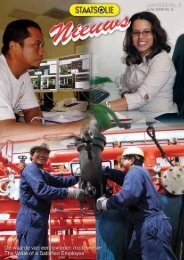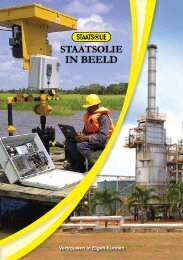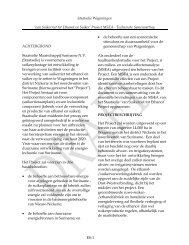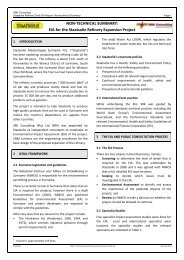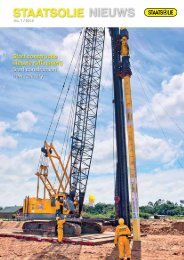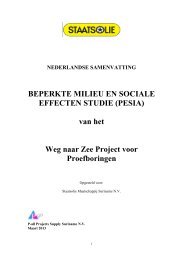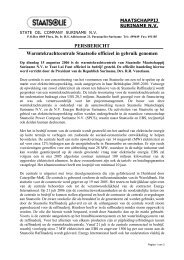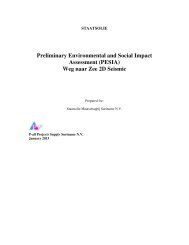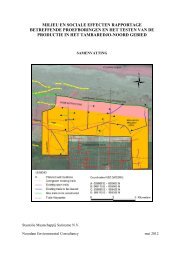concept EIA-rapport - Staatsolie
concept EIA-rapport - Staatsolie
concept EIA-rapport - Staatsolie
Create successful ePaper yourself
Turn your PDF publications into a flip-book with our unique Google optimized e-Paper software.
SRK Consulting: Project No: 439414 <strong>Staatsolie</strong> Pipeline <strong>EIA</strong> – Draft <strong>EIA</strong> Report Page 4<br />
A draft Environmental Act (2002) has been developed as a framework law in response to the 1992<br />
Rio declaration. The draft Act lays down rules for the conservation, management and protection of a<br />
sound environment within the framework of sustainable development. The draft Act has been under<br />
consideration by the Council of Ministers for some time and has not yet been promulgated. After<br />
acceptance by the Council of Ministers and the Council of State, the draft Act will be considered by<br />
the National Assembly for promulgation. Nevertheless, the principles in the draft Act provide<br />
guidance for conducting an <strong>EIA</strong> in Suriname. The two principal legal requirements of the draft Act<br />
that are relevant to the <strong>Staatsolie</strong> pipeline project and the <strong>EIA</strong> are the requirements relating to the<br />
preparation and execution of <strong>EIA</strong>s (Section 2 (2.2)), and the requirements relating to permitting<br />
procedures (Section 2 (2.3)).<br />
While there is currently no legislative basis for the assessment of environmental impacts of<br />
development proposals in Suriname, NIMOS has published Guidelines for Environmental<br />
Assessment (EA) in Suriname. The EA Guidelines are being applied by NIMOS as part of the<br />
project permitting process and project developers are expected to comply with the guidelines.<br />
The EA Guidelines series consists of the following volumes:<br />
• Volume I: Generic (2009) – This volume contains general guidelines for determining the need<br />
for an EA, the nature and extent of the analysis required and the procedure that should be<br />
followed in conducting an EA. The guidelines cover aspects such as project screening,<br />
classification of projects, scoping guidelines, public consultation, structure of EA reports and the<br />
EA report review process, including criteria for review and compliance checklist. Project<br />
screening is required to determine the need for and required level of EA. Projects are classified<br />
according to three categories, namely Category A (EA is mandatory), B (some form of<br />
environmental assessment is required) or C (no environmental assessment is required).<br />
The proposed construction of the three pipelines has been classified as a Category A project<br />
under the listing of “Pipelines for oil and/or gas” and a full <strong>EIA</strong> process is therefore required.<br />
• Volume II: Mining (2005) – These guidelines are not relevant to this project.<br />
• Volume III: Forestry (2005) – These guidelines are not relevant to this project.<br />
• Volume IV: Social Impact Assessment (2005) – These guidelines provide an outline of the<br />
requirements for conducting Social Impact Assessment, whether as part of an EA process or<br />
required independently for projects that have potential impacts on the social environment.<br />
• Volume V: Power Generation and Transmission Projects (2005) – These guidelines are not<br />
relevant to this project.<br />
2.2.2 Other environmental legal requirements<br />
A draft Waste Act (2004) has been compiled but not yet promulgated. The draft Act sets out<br />
regulations for the treatment of waste materials to protect the environment, based on the “polluter<br />
pays” principle. Different types of waste materials are identified and rules laid down for adequate<br />
storage, transportation and treatment (including recycling, composting and disposal) of each waste<br />
type. The Act makes provision for the prosecution of transgressors. The draft Waste Act is<br />
synchronised with the draft Environmental Act to ensure that there are no inconsistencies.<br />
Other legal instruments governing environmental management in Suriname, categorised according<br />
to the environmental issues that they address, are presented in Table 2-1 below. Note the table only<br />
lists key instruments and is not necessarily comprehensive, and not all of the listed instruments<br />
necessarily apply to this project.<br />
REUT/DALC 439414_<strong>Staatsolie</strong>Pipeline<strong>EIA</strong>_Draft <strong>EIA</strong> Report_Final June 2012


